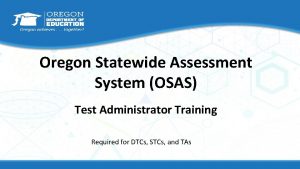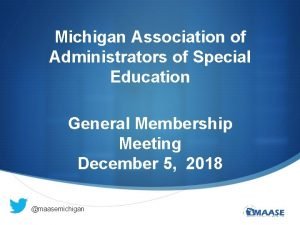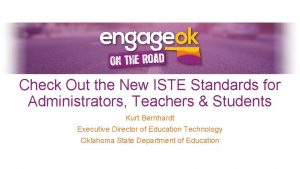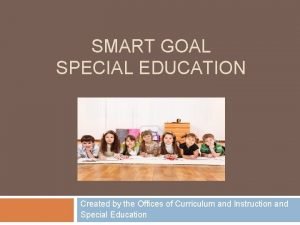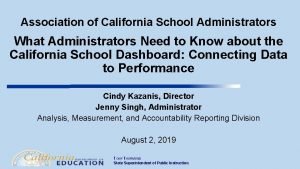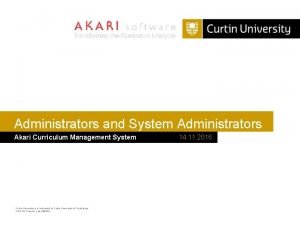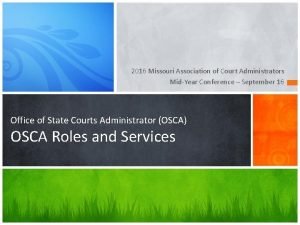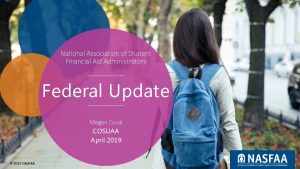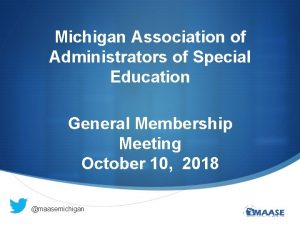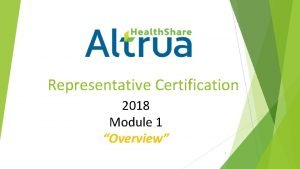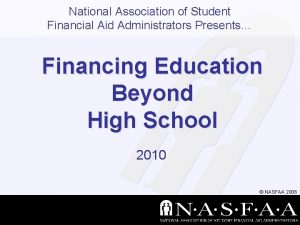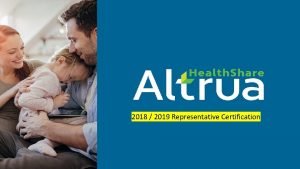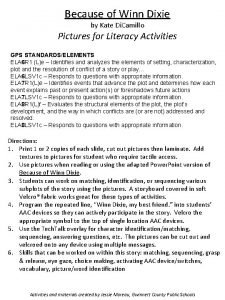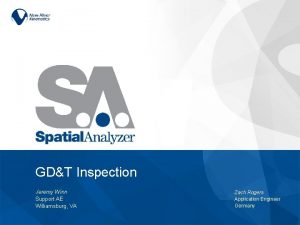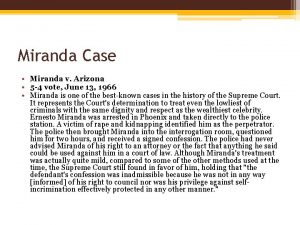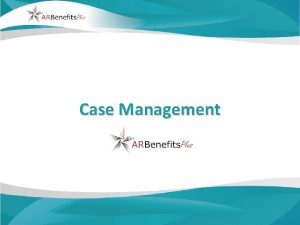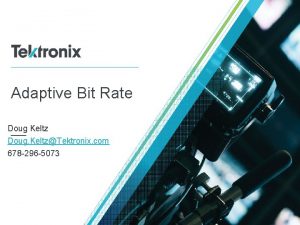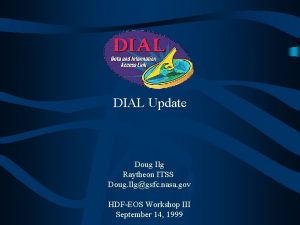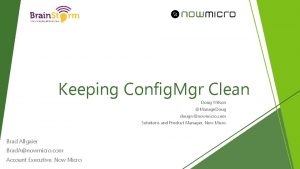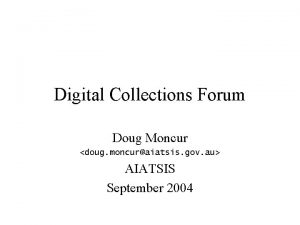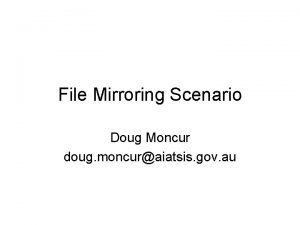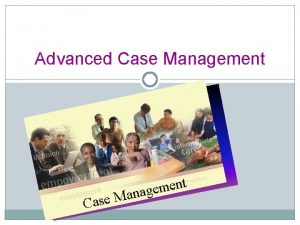Administrators Role in Case Management MIRANDA WINN DOUG































- Slides: 31

Administrators Role in Case Management MIRANDA WINN DOUG MATEAR BRUCE GARNETT

Your Presenters MIRANDA WINN, DOUG MATEAR, BRUCE GARNETT CASE MANAGER-BEHAVIOUR & DISTRICT PRINCIPALS

ICE BREAKER-- What qualities does an effective case manager have?

Review understanding and role of an admin. case manager What to expect in this workshop CB IEPs, ICMs, Audit Prep for Sped, and AIPs. RTI and School Based Team Resource sites

School Based Case Manager

CB IEPs, ICMs, Audit Prep for Sp. Ed and ELL

CB IEPs “Are documented plans developed for students with individualized learning needs’ CB IEPs: - reflect BC’s renewed curriculum - mandatory K-7 starting in Sept 2019 - training is being offered in Sept-Oct ‘ 19

General student info populated by My Ed Student profile (interests, learning preferences, etc) Learning profile written in 1 st person- outlines strengths, and stretches for Personal, Social, and Intellectual. What do CB IEPs Contain? Essential and Universal Supports Supplementary plans (listed) Core Competency Goals Curricular Competency Goals Review…

CB IEP training sessions throughout the year CB IEP Share Point where all the CB IEP tools are kept. CB IEP drop in working sessions How does DLS Support this CB IEP tools include: - Self-assessments - Core competencies cheat sheet/designation - Objective bank - Quick Reference Guides - CB IEP examples

Ensure that: - All designated students have a CB IEP (K to 7) What do Admin need to know/do? - Staff who are writing them attend CB IEP training AND have proper view access on My Ed • Core Competency goal aligns with the student’s designation (see Cheat Sheet) - Students are required to have at least ONE Curricular Competency Goal - IEP meeting and parent communication takes place in a timely manner (in the fall) - The CB IEP is reviewed mid-year or at year end - A hard copy of the CB IEP is kept in the student’s red file and an e-copy is on My. Ed

MCFD/VACFSS – social workers, family preservation workers MCFD CYSN (Children and Youth, Special Needs) BC Centre for Ability Inter-agency Involvement ICMs OT, PT, (VPT) Doctors, psychologist, psychiatrist , specialist Sunnyhill, BC Children’s Hospital, SET-BC VCH Child and Youth Mental Health (CYMH) Home Team –Private behaviour Consultants/behaviour interventionist, Private OT/SLP/PT/Counsellor

When do we have Interagency Case Meetings? • Have them when the student has a team of support and there are complex needs. • Should align with the IEP process • Minimum of 1 x per year or as required. ALL H students need one per year. • When there is a crisis or change that dictates coming together as a bigger team to problem solve • To identify key changes in needs and to possibly review and update employee safety plans • To create a comprehensive plan, set goals, set dates for follow-up • To track progress

Before you plan an ICM meeting… • Parental permission is REQUIRED to communicate with outside agencies with a current Consent for Release of Confidential Information • All Consent for Release of Confidential Information forms are valid for only 1 school year. • If a student moves schools, a new consent form should be signed.

Each student that receives additional funding for ELL, Special Ed or Aboriginal Ancestry is identified either by a specific coloured dot on the PSR file or has a specified colour coded file that is located with the PSR file. Colours are as follows: Red – Special Education Blue – Aboriginal Ancestry Green- ELL Contact Aboriginal Education consultant and ELL Consultants for audit-ready information. SPED Audit Ready Checklist

Inclusions for Special Education files (letters A-R): updated annually Ministry Special Education Funding Checklist for designation CB IEP – first goal must reflect designation SPED Audit Ready Checklist Instructional Support Planning Tool used and included as needed Psycho-educational testing SLP reports STIBS reports Vision/hearing reports Pediatric assessments SETBC referrals Functional Behaviour Assessments Physiotherapists care plans Occupational therapist care plans Legal alert or court orders Note: Testing protocols are not included in Special Education Red File

Ensure that: Admin and SPED Audit Preparation - all designated students continue to meet the criteria on the Ministry Checklist for their designation. H’s must be annually supported by ICM, Behaviour assessment, IEP, and outside agency support. - For students who don’t meet the criteria, we must remove or add the designation before Sept 30 th. - The Ministry Checklist for their designation should be stapled to the inside cover of their red file. - Red file is organized using designation dividers (found on the share point). - Any ‘provisional’ designations should be followed up by the case manager to ensure all supporting paperwork is in the file.

What documents should NOT be kept in the RED Special Education file? • VSB Employee Safety Plan: Should be kept in the Administrative Officer file, Substitute notes for Support Staff and the Classroom Teacher • Needs Assessment requesting SSA Support: Should be kept in the Administrative Officer file • Violent Incident Reports: Should be kept in the Administrative Officer file • Violent Threat Risk Assessments: Should be kept in the Administrative Officer file • Assessment Protocols

NWC Bruce Garnett AIPS- Annual Instructional Plan for English Language Learners

Guesses? What kind of ELL students generate supplemental funding? How many ELL students does the VSB have? How much supplemental funding is generated by VSB’s ELL students (either per student or per year)?

Supplemental funding 20192020

The Green Audit Compliance Book Updated annually and distributed to all schools NWC Portal Resources Mock audit checklist Mock audit video Secondary adaptations Timelines of task completion Blank AIP templates Matrices in translation Email Bruce for a link if necessary Audit Compliance for Administrators Presentation 3: 30 - 5: 00 PM, Sept. 16, 2019, NWC. RT sessions Sept. 9, 11, 13 and 16 Some for new to role, some for veteran teachers

Because we get supplemental funding for ELL, we must: • Prove the student needs extra English language support; • Show we have a plan to provide that extra support; • Show that we are implementing that plan in an ongoing way; • Show that we are communicating the plan, the support, and how well it is working to the parents.

1701 data collection instructions specify six criteria: 1. The student’s use of language is significantly different than standard English and requires additional specialized services to meet provincial learning outcomes. (indicated by DRPC or annual assessments) Who qualifies for supplemental ELL funding, and how? 2. There is an AIP in place dated prior to Sept 28 of this school year (actually anything dated after Sept 30 of the previous year) 3. An ELL specialist is involved in the AIP’s development, and ongoing review. 4. There is evidence of additional services being provided prior to Sept 30, and ongoing throughout the school year. 5. There is a schedule of the support provided by an ELL specialist teacher, staff or a list of the specialized services provided to the student. 6. There is documentation of the student’s progress in English acquisition in all student progress reports.

Timeline: Complete these tasks before Sept. 30, 2019 1. Ensure all eligible ELL students (including Ks) are entered into My. EDwith 39 ELL code for supplemental funding. 2. End ELL supplemental funding for students who no longer require service or who have completed five year of service. ◦If student still requires ELL service after five years, add program code 39 ELL Over 5 Years 3. Ensure all ELL students are receiving some sort of documented additional ELL support by Sept 28. ◦For secondary, this support will likely be in the form of adaptations. 4. Ensure there is a completed file for all claimed ELL students. ◦AIP – including marked writing sample ◦ELL matrices/ ELAR report for elementary ◦A student timetable indicating that ELL support began prior to Sept 30. ◦For secondary, file must contain a hard copy of student timetable that shows ELL, ELC or transitional classes and two adaptations created by mainstream teacher in consultation with ELL specialist, and a classroom adaptations checklist. 5. Keep the 1701 file at the school even if the student transfers/leaves etc.

• Students can only be claimed for ESD support if they meet the same criteria as ELL students. Specifically their English must “differ significantly from Standard English used in school, ” and all the same documentation must be in place. What about ESD? • PLUS: there must be an oral language component to their language needs. Services that address deficits solely in literacy are not sufficient. • Accent reduction is not an ESD service, nor is speech language therapy for language development disorders. • Beyond these criteria, there is no Ministry guidance as to what constitutes an ESD student. • Claiming a student for supplemental funding due to ESD simply because he or she is of Indigenous ancestry is not a supportable practice. • ESD should be reframed as English Skills Development.

RTI & SBT

1 -5% Tier 3: District Involvement, Outside Agencies (OT, PT, etc. ), Psych Ed Assessment, etc. 1 -10% Tier 2 b) SBT (RT to complete PRIS and submit to SBT chair if further action is needed ) 5 -10% Tier 2 a) RT involved and may assess further. RT may schedule support for student. 80 -90% Tier 1: Classroom Teacher assesses class, sees a student who is struggling and adapts program, observes, and completes tier 1 (page 1 of PRIS) if they feel RT support is needed


School Based Team and the PRIS Prior to SBT, referrals should have a completed PRIS submitted to SBT chair. ALL informal assessments and observations should be recent and indicate a significant challenge in the area of question. Ø All assessments should take place before SBT Ø Formal data should be based on age not grade Ø Data/PRIS should point to a tier 3 direction

Advantages of using RTI for SBT When we stop scheduling students on SBT for: red flagging, accessing school-based supports, or problem solving at the tier 1 -2 level, we can: - cut down on number of meetings - meetings more focused/efficient - higher quality of information - streamline ‘invitation’ process Disadvantages?

• Provincial Outreach Programs o POPARD (asdoutreach. ca) o PISP (www. pisp. ca) o POPFASD (www. fasdoutreach. ca) o POPEI (https: //popei. sd 38. bc. ca/) • SET BC • Share Point Sites (CB IEP, Student Services, etc) • VSB Portal • Student Support Newsletter • Shelley Moore, Jennifer Katz Resources
 Miranda winn
Miranda winn Best case worst case average case
Best case worst case average case Monica brewed espresso steamed milk
Monica brewed espresso steamed milk Osas portal .org
Osas portal .org Michigan association of administrators of special education
Michigan association of administrators of special education Iste student standards poster
Iste student standards poster Hbcu title iii administrators
Hbcu title iii administrators Smart goals for special education administrators
Smart goals for special education administrators California association of school administrators
California association of school administrators As were many colonial administrators gregory was
As were many colonial administrators gregory was First nations education administrators association
First nations education administrators association Crown healthshare administrators
Crown healthshare administrators Akari curriculum
Akari curriculum Missouri association of court administrators
Missouri association of court administrators Dilignece
Dilignece Black public administrators
Black public administrators National association of financial aid administrators
National association of financial aid administrators Michigan association of special education administrators
Michigan association of special education administrators Crown healthshare administrators inc
Crown healthshare administrators inc International global assistance
International global assistance National association of financial aid administrators
National association of financial aid administrators Crown healthshare administrators inc
Crown healthshare administrators inc C# azure worker role example
C# azure worker role example Krappmann modell
Krappmann modell Statuses and their related roles determine
Statuses and their related roles determine Fenske equation determines the
Fenske equation determines the Because of winn dixie
Because of winn dixie Because of winn dixie genre
Because of winn dixie genre Because of winn-dixie book and movie comparison
Because of winn-dixie book and movie comparison Dixie heights high school
Dixie heights high school Sageny
Sageny Jeremy winn
Jeremy winn



